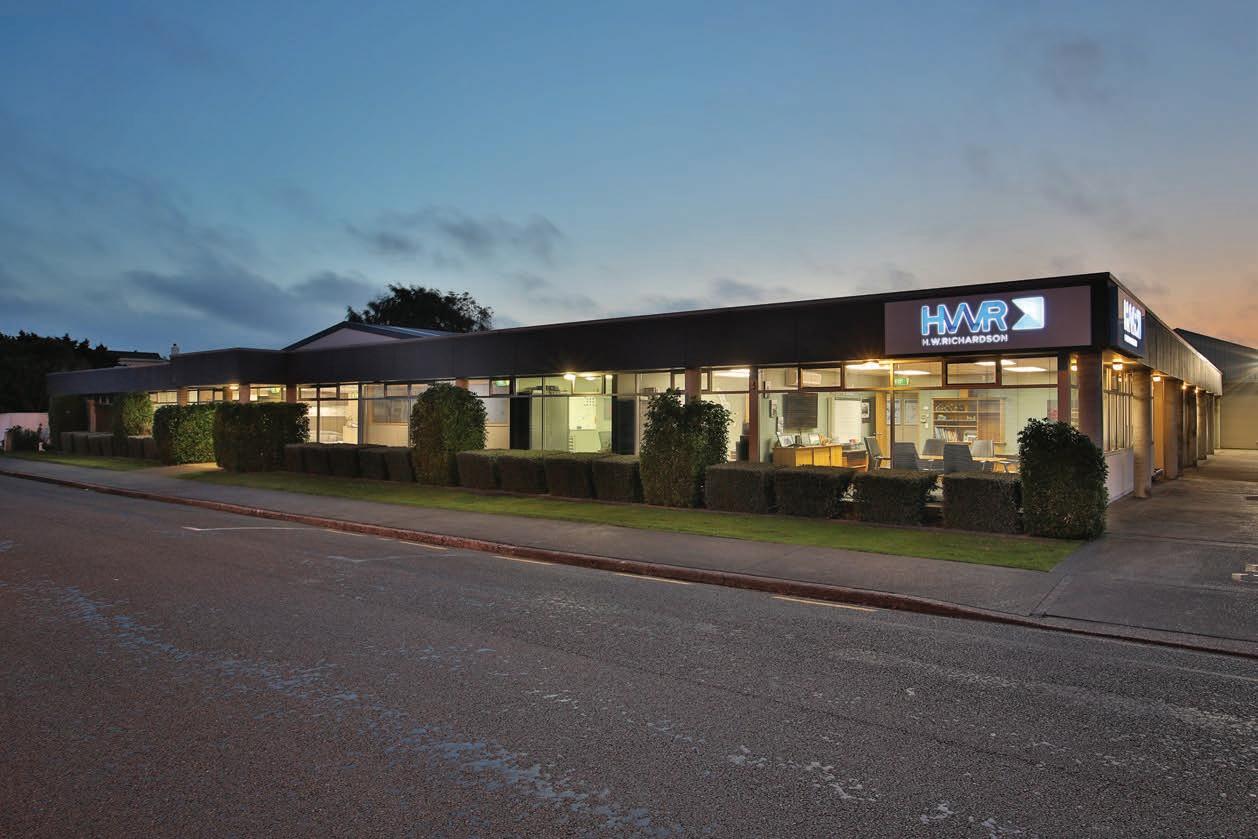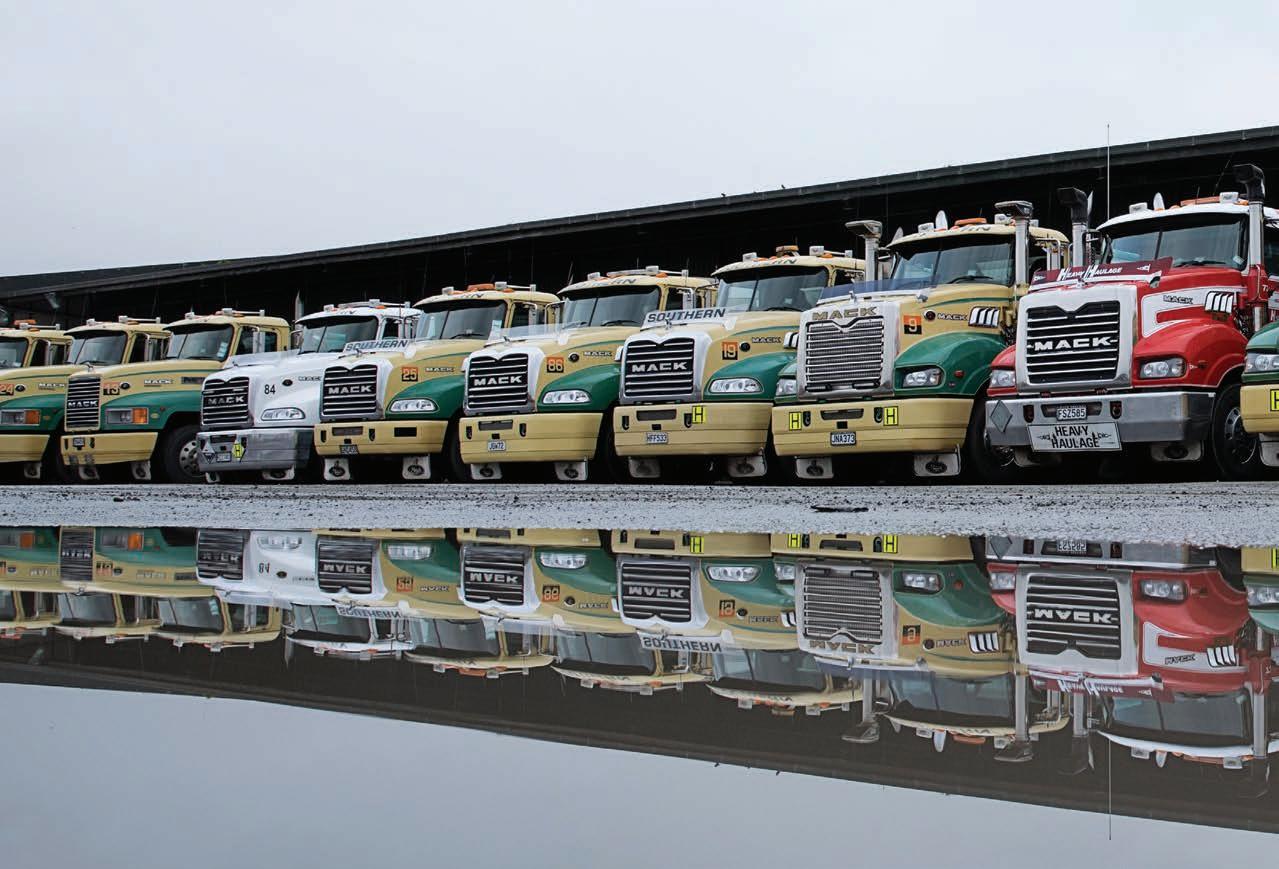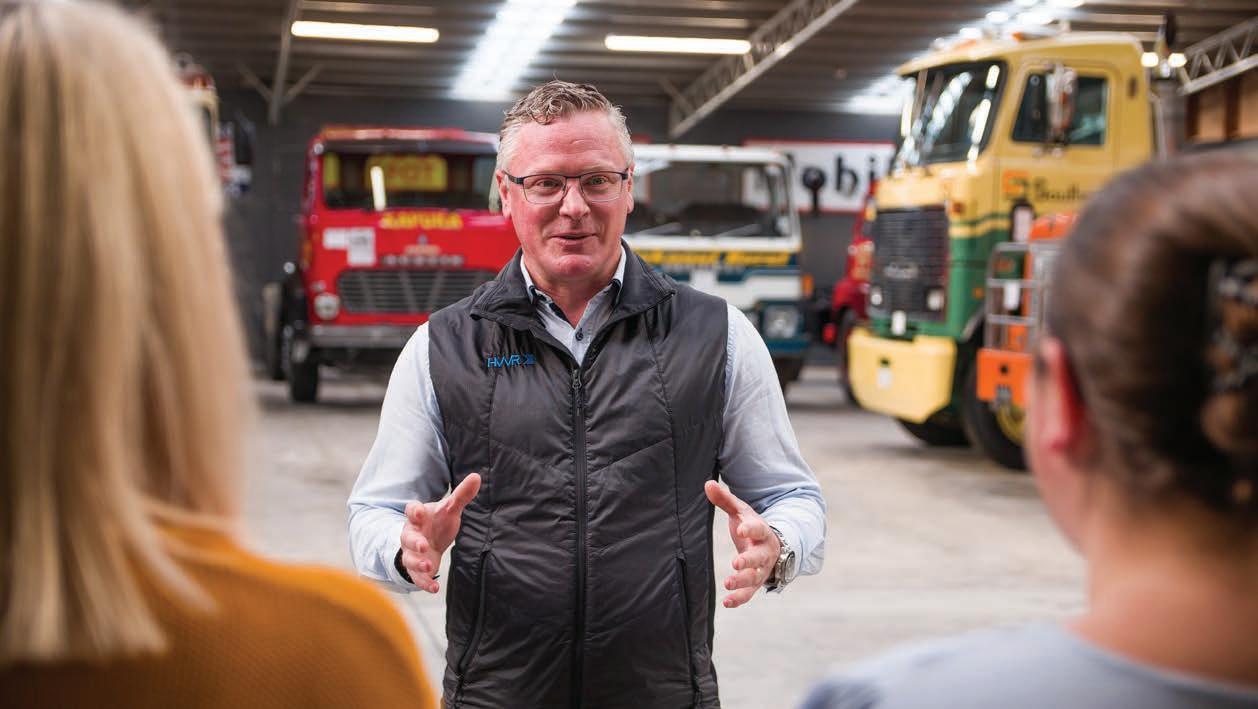
12 minute read
New boss at HWR
Anthony Jones has recently moved from Sydney to lead HWR Group as the new CEO of the Southland-based company.
Moving South
By Colin Smith
Moving from across the Tasman, Anthony Jones has made Southland his new home as he brings a diverse logistics background to the CEO’s office at HWR Group.
ANTHONY JONES JOKES THAT HIS FAMILY – WIFE KATIE
and their four children – made up a good proportion of New Zealand’s net migration total in 2021.
The family made the move from Sydney to settle in Invercargill in mid-December where Jones has been working into his new CEO role with Southland-based HW Richardson Group (HWR Group), one of New Zealand’s largest privately owned companies.
Jones takes on the CEO role replacing director Scott O’Donnell, who had been interim CEO since the retirement of Brent Esler in 2020.
The small statistical significance of the Jones family in the migration numbers is just one small reminder of how much the world has changed as the past two years have been dominated by Covid-19.
Border closures, traffic light settings and staff shortages combine with global supply chain pressures and future energy solutions as subjects which have Jones attention. At the same time, he’s been attempting to tour New Zealand to meet as many of HWR’s 2500 staff and their customers as possible.
“I tendered my resignation with Linx Cargo Care two weeks before Delta hit the shores of Australia with the assumption in my head that, ‘it’s all good, we’ll jump across the ditch’,” says Jones.
“My intent at that stage was I would come across and the kids would finish out school and come across after that.
“Delta got in the way. The bubble shut and stayed shut for two months. It wasn’t a case of not being able to get into MIQ, it wasn’t even open.
“It took six months to get here from the time I resigned to when we got into the country.
“We landed in Auckland on the second of December. We were one of the lucky ones who got seven days in Auckland and then we flew down here [Southland] on the 10th of December.”
Now the pandemic is interrupting Jones’ plans to get acquainted with the organisation he leads.
“I have been to most of our JV operations around the South Island but there’s still a couple I need to get to,” he says.
“I wanted to go to the North Island but that was the week we moved into red setting. I unfortunately haven’t been able to get up there. That was mainly our customers choice, they moved to say they didn’t want face-to-face.”
With Jones’ focus very much on people and relationships, the
HWR head office is currently located at Inglewood Rd in Invercargill. The company plans to occupy the top four floors of a new nine-floor development due to open late-2022 in the Invercargill CBD.

visits remain a high priority.
“I don’t what to be the person who has been in a role for six months or a year and some people say, ‘I’ve never even seen that guy’.
“That’s not who I am. We are starting to pivot to Zoom and Teams so there is a face to the name, but ultimately there will be a bit of that road show stuff because that’s who I am.
That’s what I value.
“It’s about getting out and putting faces to names. We have some amazing people within the business who are genuinely passionate about seeing their customers freight move efficiently to market.”
There are plenty of other issues focussing Jones’ attention.
“It’s an interesting time. None of us knew what a pandemic was two years ago. We’re trying to grapple with that,” says Jones.
“We have the near-term challenge of getting through the pandemic and keeping the wheels moving.
“The interesting thing is the Covid pandemic has brought to the fore how critical supply chain and logistics is. It’s shone a light into the industry for a lot of people. They didn’t realise how their toilet paper, for instance, got onto shelves before.
“If you stop something, what happens? People don’t have those bare essentials.”
Manufacturing lead times and maintaining capital investment is another challenge.
“There are manufacturing challenges around the world for any commodity and that includes trucks,” says Jones.
“Those types of lead times are good for a manufacturer because they are getting good order books. But for operators who are trying to keep equipment running or might have missed the boat and not had mature systems to replace equipment with good capital programmes, it’s putting a bump in the road.”
Jones also says it’s an era of energy shift and questions are being asked about how long diesel trucks are going to continue to operate.
“The alternate energy is actually causing a bit of disruption and probably uncertainty for some people. That’s only going to proliferate more,” he says.
“For us it’s not only road transport. Road transport in some of our businesses is how we get our product to market - like our Allied Petroleum business.
“Some of things that have my attention are, how do we start to bring in new technology that allows industry to transition while reducing carbon emissions? That’s got a large focus from myself and there are some really exciting things that we’ll be announcing soon.”
Labour and skills shortages are a problem across many industries with transport at the forefront.
“We just really struggle to get bums on seats. The closed border saw a net migration number in the hundreds last year. It’s encouraging to see the plan the government now have to open those borders because it is a real issue.”
HWR has developed some innovative programmes to attract staff.
“One of things we are tackling as a business is getting in front of kids at an early age to show how important of an industry we are, and how much of a fun industry we can be,” says Jones.
“There is a bit of that stigma sometimes that can be talked around the kitchen table, which is not fair. We are tackling that as HWR by being in front of school kids, getting them to understand what a truck looks like and how sophisticated a truck is.
“It’s important to get to the kids before they are influenced negatively and say, ‘look, this is a great career’. It’s been a great career for me especially and for many others.
“It’s a people business and we are driven by people, literally and figuratively. They are what make or break you.”
Jones says he hadn’t heard of HWR Group before the Southland-based company reached out during its recruitment for a new CEO well over a year ago.
“I didn’t even know the brand,” says Jones.
But once Jones began to learn he liked what he saw.
“They reached out to me. I didn’t need to leave [Linx] but the attraction of joining their company is what continued the conversation.
“Covid got in the way. We continued to talk through Covid, but it was clear we weren’t going to be able to meet. But once the borders did open up, we did get to meet and that just affirmed everything.
“It was April 23rd when we made the jump across Tasman. We got to know them over a weekend.
“When I met Scot and Joc [O’Donnell] and with Albert [Brantley, HWR Chairman], it really was the values of the company, the lineage of the company and what the company stood for and did that attracted me to continue a conversation with them.
“With any position of this type it’s really important it works for both parties. We got to know each other pretty well.”
Jones knows the opportunity for a CEO role with a large privately owned company is rare.
“You don’t come across businesses like this very often and normally when you do it’s run by a generation of the family,” he says.
“I have the greatest respect for that connection back from Bill’s [company founder Bill Richardson] lineage, creating this business from a very small cartage business to what it is today.
“The entrepreneurialism that sits in the business and the genuine care for their people is what really attracted me. These opportunities don’t come up very often.
“I’m pretty simple in that I want to work for good people, I want to make a difference and I want to be challenged. They have been the same drivers all the way through my career.
“I do see a huge amount of opportunity for the business. It’s not often that you see a business this size and scale but also with healthy entrepreneurialism and a healthy balance sheet to be able to take those opportunities.”
Jones says a business like HWR Group which operates across six sectors and has 48 brands comes with a huge amount of complexity.
“Do I like challenges? Yes. Was I scared off by the complexity? No,” he says. “The diversity actually is an attraction. It was one of the things I used to really enjoy about my previous role. I used to say that one day you’d be watching a tree-felled in one of our plantations and the next day watching a Porsche being loaded onto a car carrier.
“And HWR is no different. One day we could be out with one of our transport operators loading sheep onto a truck and then the next day I could be sitting there with my transport team on the leading edge of transport technology or dealing with some of the things we are doing in alternate energy. It’s an exciting diversity.”
The other thing Jones is looking forward to is enjoying what the South Island has to offer with his family.
“I’ve been married to my beautiful wife Katie for 20 years and we’ve got four kids - three crazy boys and one beautiful girl. My daughter is the eldest at 13 and the boys are 11, 9 and 6.
“We are a snow sports family, and we love getting out and about in the outdoors. Hence the attraction of Southland and the beautiful South Island.” T&D

By Colin Smith

New HWR Group CEO Anthony Jones brings experience across all transport modes, with the exception of air freight.
A diverse career
APPROACHING 25 YEARS IN THE LOGISTICS AND SUPPLY
chain sectors, new HWR Group CEO Anthony Jones brings a diverse CV and multi-mode experience to his new role with one of New Zealand’s largest privately owned companies.
Jones began his logistics industry career in Sydney as a casual stevedore for Patrick Corporation in the wake of Australia’s industrychanging 1998 waterfront dispute.
“I drove forklifts, trucks, cranes, straddles and did a bunch of clerical jobs for about two years,” he says.
“I got pretty bored reading the paper three times a day and so at the time Patrick was starting up its own rail freight company off the back of frustrations with the government-owned freight rail. I jumped into that start-up business.”
His initial role was running port shuttle services from the western suburbs of Sydney into Port Botany. At the time Australia’s logistics and freight industry was undergoing massive changes and shortly after that Patrick and Toll bought the federal and state-owned railways in Australia and formed Pacific National.
“I jumped across and spent 12 years in Pacific National. My first role with them was at Melbourne Freight Terminal, so containerised freight was a large side of my career. I spent a big proportion of my time in containerised freight and logistics.”
Jones says he had numerous roles in Melbourne Freight Terminal and then moved back home to Sydney.
“My wife and I were married during the time we were in Melbourne, and we came back up to Sydney.”
Jones took a terminal manager role, became a state manager and then moved to general manager of bulk rail freight with Pacific National.
“GrainCorp were our biggest customer. We were moving everything other than coal. Coal was a separate division, but everything else that went into a bulk rail wagon, we moved.
“Then I moved back into the Patrick business. At the time Pacific National and Patrick were owned by a company called Asciano, which was ASX listed.
“I jumped back into Patrick. I did some restructure work and consolidation work. We’d recently bought a business that we’d bought into the fold, and we integrated that to form a pit-to-port, paddock-toport operation, end-to-end supply chain solution.
“Not long after that I became GM for Patrick. Both bulk and containers across the nation.”
That role included responsibility for the major ocean terminals in Brisbane, Sydney, Melbourne and Fremantle along with landside logistics and bulk port operations.
“Asciano was sold in 2016 and it was divested and de-merged. The business was split up into three different groups - one being Pacific National, one being the Patrick Ocean Terminals business and the other being the Patrick bulk and general businesses which had five brands,” says Jones.
“We had to rebrand that business and I became the CEO of that business, which became Linx Cargo Care Group.
“We established that business from what was previously a business unit in amongst a large ASX corporate to standing it up on its own two feet.
“That was my last five years. It got to the point where the team was ready for somebody new, and I was probably ready for something new as well. So here I am.
“So, the summary is I’ve worked across all modes except for air freight.
“We used to run a very large trucking fleet in Linx, we probably had circa 600-700 trucks on the road at any given time and we had rail operations in amongst that and port ownership [the Geelong Port].
“I come from a diverse background. I am a transport and logistics person and for me it’s about how do we bring the strength of our offering for the benefit of our customers and continue to evolve the supply chain, so our customers get the best service and best access to markets for their products.
“That’s what I’ve been doing for the last 20 years, some in smaller sums than others. The Linx Cargo Care Group was very similar to HWR Group in its diversity.” T&D


